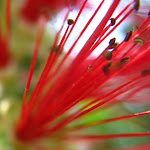

During our mountain trip to the Swedish 'fjällen" the name for the alpine mountains in Sweden, we visited Fulufjället National Park (English link1, link2). I hadn't been there since fourth grade I think, and it is a lovely place. The mountain is large and flat, and in the northwestern part of Dalarna province. We stayed in the hostel in the village of Mörkret (=Darkness!), which is next to a large enclosed area with wild moose (Moose Adventures). One of the moose had had twins earlier that year, and we saw them through the tall electric fence (it was late, dusk and rainy, so the photo is not good). If you buy a ticket you can go inside the fence and see all the moose better, including the giant bull, The King of the Forest ('Skogens Konung').
It had rained for days, so everything was wet, including the gorgeous lupine flowers that actually come from North America and have spread like a pink-lilac-purple wildfire over Sweden.




The next morning we drove a couple of miles up to the entrance to the National Park, at Njupeskär, the tallest waterfall in Sweden. It is about a mile's hike up to the waterfall, first through boardwalks and trails on bogs, and then through an old virgin spruce forest filled with ferns, blueberries, lichens, mosses, and some mosquitoes. The lichens are amazing, from the 'map lichen' (kartlav), which grows extremely slowly on rocks and makes topographic maps in its patterns, to the lobaria (lunglav) that we saw on a few birch stems. The lobaria looks like lung lobes, and was therefore used as lung medicine in the old days. The soldier lichen is cool with its red spore-bearing parts on top of small trumpet-shaped structures.
It was still raining but not so hard, so my photos are not the best. On one spruce tree we saw the markings of the three-toed woodpecker (tretåig hackspett) that had looked for food, probably bark beetle larvae or other insects. The fireweed (mjölkört) was flowering, and flies took refuge in the flowers that provided shelter from the rain. On the bogs where some cloudberries (hjortron), but not too many. To find lots of them you have to go away from the trails. Old log cabins, without Falu redpaint here in the north!, provided shelter to hikers.










Near the parking lot is a small interactive science center, a Naturum (nature room), which is one of the best I have seen anywhere. The design is astonishing - one wall is all glass an out towards the bog, with not one human-made thing in sight. Kids (and adults) can sit and watch the birds with provided spotting scopes. There is information about the forest, forest fires, mammals (including wolves and bears), birds, lichens, weather (which is extreme here by Swedish standards), and history.
Things are arranged so that toddlers also have things to look at, it is at all levels, which I really like. You can touch and hear different animal's fur and sounds, look at videos of forest fires, and find out what you saw during your walk. Nothing is plastic, or at least you don't get that impression, everything seems to be sustainable and from natural origin (wood, rock), except for some metals.
One cross-section through an old pine tree showed healed fire damage nine times since 1497 - so this tree is older than Colombus' discovery of America. And it was just a tree like any around here. Well, a lot of Dalarna was clearcut for the mining industry, but the logging didn't reach all the way up here, thankfully. Another tree was standing at a road crossing and people carved their initials or signatures (bomärken) and year into it for the last 200 years at least. That tree fell down and the trunk was preserved here as part of the local history.







One of the typical rocks in the area is porphyry (porfyr), a kind of rock that locks like colored clay with little tiny dots in it. The basic color can be many, here is Blybergsporfyr which is dark with light dots. Many more photos from Fulufjället kan be seen here.
 Only one hour left to EH's birthday in Sweden, and since I am usually late with congratulations overseas, here comes one 1/24th of a day too early! The photo is of a hummingbird on a ring gentian (Symbolanthus pulcherrimus, 'the beautiful ring gentian') in Panama. Yippee for EH, and how does it FEEL to be an age divisible by 2, 4, 5, 10, and 20?
Only one hour left to EH's birthday in Sweden, and since I am usually late with congratulations overseas, here comes one 1/24th of a day too early! The photo is of a hummingbird on a ring gentian (Symbolanthus pulcherrimus, 'the beautiful ring gentian') in Panama. Yippee for EH, and how does it FEEL to be an age divisible by 2, 4, 5, 10, and 20?






 Christer Fuglesang showing new swedish space stamps, below the STS- 128 emblem.
Christer Fuglesang showing new swedish space stamps, below the STS- 128 emblem.















































